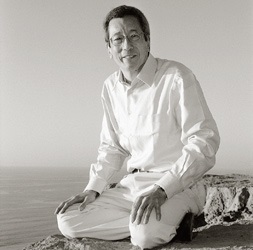
Roger Y. Tsien has said that he is "doomed by heredity to do this kind of work", which says a lot for a man who is very distantly descended from King Qian Liu (Tsien Liu) of Wuyue in China. Tsien’s modest claim, however, refers to the extraordinary number of respected engineers, from chemists to rocket scientists, in his extended family. Indeed, he often refers to his own work as ‘molecular engineering’.
He was born on February 1, 1952 in New York City and grew up in Livingston, New Jersey, where he attended the local high school. His first early success was at the age of 16, when he won the national Westinghouse Talent Search with a project analysing how metals bind to thiocyanate. He gained a National Merit Scholarship to Harvard, graduating with honours in chemistry and physics in 1972. He then moved to Churchill College in Cambridge, England on a Marshall Scholarship to study physiology, receiving his Ph.D. in 1977 and staying on as a research fellow at Gonville and Caius College until 1981.
Returning to the US, Tsien joined the faculty at the University of California in Berkeley but in 1989 switched to the University of California, San Diego as Professor of Pharmacology, Chemistry and Biochemistry, and an investigator at the Howard Hughes Medical Institute. At Cambridge and Berkeley, Tsien developed molecules to track and control the levels of calcium inside cells, regulating nerve impulses, muscle contraction and fertilisation. But the move to UCSD made it possible to explore signals transmitted through more complex biochemical, such as cAMP (cyclic 3',5-adenosine monophosphate) and the wider range of macromolecular interactions, and realized that genetically encoded fluorescent molecules like Green Fluorescent Protein (GFP) could be the key.
Like Martin Chalfie, he acknowledges the generosity of Douglas Prasher: “I called him up, and to my amazement he was willing to give out the gene", Tsien says. Armed with the gene that created GFP in the Aequorea victoria jellyfish, Tsien’s team found ways to adapt the protein and red relatives from corals to improve their practical use by scientists. Introducing several variants of the protein made it possible to track and monitor a range of molecular processes simultaneously, in all sizes and types of cells, without disrupting cell function.
He was a co-founder of Aurora Biosciences Corporation, which used GFP for high-throughput drug screening and of Senomyx, a company using such screening technology to discover flavour modifiers.
Tsien has received numerous awards for his work and is a member of the Institute of Medicine, American Academy of Arts and Sciences, US National Academy of Sciences and Britain’s Royal Society. Together with O. Shimomura and M. Chalfie he received the Nobel Prize in Chemistry 2008 "for the discovery and development of the green fluorescent protein, GFP".
He married Wendy Globe Tsien in 1982.
Roger Tsien passed away on 24th August 2016.
